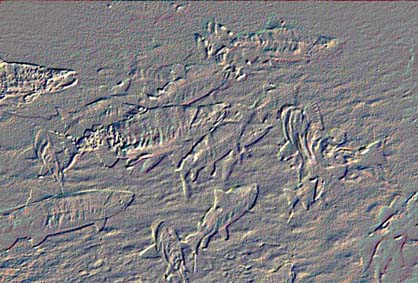

A new book - "Flyfishing the Russian Far East"
Out of a chapter "Floating the rivers of the Far East" - part II ("Nakhlyst" magazine, #1, 2004)
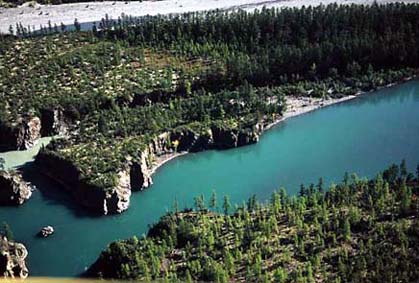
"The Gates" of the Yudoma River (Lena River drainage)
Some rivers divide into channels, which can separate and flow far from each other. So, the length of the Schuchya (Pike’s) channel in the Anadyr River valley is over 150 km. This channel goes far to the north from the main river, leaving out the only village in that area – Markovo. If you are floating down the Anadyr River 60 km upstream from Markovo, do not turn left, into full-flowing Schuchya – the next human dwelling will be in hundreds of kilometers downstream! Similar channels, which go far away from the main river, are found in the valleys of Amur, Penzhina and other big lowland rivers.
Modern GPS devices are extremely handy in the wilderness trips, especially the models with built-in maps. The scale of these maps can be 1:500 000. This is not enough to orientate yourself in complicated conditions (fog or lowland forest); it is better to take along topographic maps as well. The most convenient scale of the map is 1:100 000; the 1:200 000 scale has fewer details, but is useful as well. Some rivers have monotonous banks and not enough prominent places to orient; it can be difficult to find your location using only a map. In such places it is better to use map and GPS together.
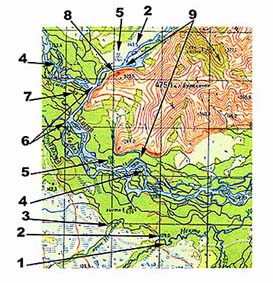
How to use a map:
1. Twisting river with small gradient. The width is sufficient for floating (denoted by the double line).
2. Altitude marks, which are used for calculating of the river gradient.
3. A small river: its channel is probably too narrow for floating (denoted by the single line).
4. Fragmentation of the main river channel into several small ones: possible log-jams area.
5. Designation of the width and depth of the river (in meters), bottom nature (hard, soft, rocky, etc.).
6. Inlets and tributaries.
7. Average current speed.
8. Rocky cliff.
9. Mouth of a dead channel (water is always clear)
A serious wilderness float-trip of budget cost level will require at least 10 days or 2 weeks. This means, you will be able to avoid using helicopters and go to the starting point of the route by car, ATV or motor-boat. This is cheaper, but requires more time. Helicopter charter fee normally takes over a half of the total trip cost. Another advantage of such approach is the possibility to travel in small groups – from one to 3 fishermen plus one-two guides. A typical group which is using helicopters has 6-8 fishermen, and the “budget” groups can be up to 12-14 members. Nevertheless many of our rivers are not accessible without a helicopter, and this is why they still are so good! Generally in a short trip one day of fishing will cost you more than in a long one. The second disadvantage of short trips is their dependability from the weather – tight schedules do not have waiting time.
In river stretches where you want to fish there is no need to make more than 10 km a day. A group of gear-fishermen can briefly fish through up to 20 km of a river a day, but flyfishing requires more time. Surely, some parts of rivers are of less interest for fishing and can be passed without many stops. Such are the very upper reaches of many rivers – they have bigger gradient and lower productivity. The main attraction of these areas is their landscape (often spectacular) and whitewater – if you are among those who enjoy it.
I remember a trip with complicated logistics, which we have organized for a group of fishermen from Western Europe. The tour has started in Kamchatka, in lower reaches of the Bolshaya River, where we have spent 4 days fishing for trout, chinook and cherry salmon. Next day we have organized a charter helicopter, visiting volcanoes, hot springs, and fishing one remote river. After that we came by plane from Kamchatka to Khabarovsk, and next morning helicopter charter took us to the upper reaches of the Tumnin River (Sea of Japan). In Tumnin we were fishing for 4 days (sea-run taimen and cherry salmon). At noon of the last, 11th day, helicopter took us back to Khabarovsk. The whole tour was blessed by excellent weather, and I was lucky with the partners as well, so we have avoided any problems. Such complicated tours are risky – any weather delay and the whole schedule will collapse.
Finally, your Journey is unrolling. You are on the water. Gear-fishermen fish a lot from a moving boat. Normally they land only in some, most attractive pools, and after some casting continue moving. Most of flyfishermen are used to and feel most comfortable when fishing from the bank or by wading. I agree that this kind of fishing is the most comfortable, but there are waters where you will have to fish from the boat. Such are low-gradient streams with steep, often forested banks. On such rivers there are not enough convenient gravel bars. Besides that, lots of good taimen rivers are big, and it is difficult to reach many of the fish locations. Fishing the Amur River also requires lots of boat fishing. So, you either will have to pass some “sure” places, or to anchor the boat and start casting. Fishermen face similar situations during floods. The main river is out of shape; the only chance to catch fish is to enter the flooded mouths of tributaries and dead channels. In such places the current is weaker, and the water – more clear (sometimes – very clear). Of course all fish wait through the flood in such places, roaming through the flooded forest, but almost the only way to catch them will be to cast from a boat. Exactly the same type of habitats – bays and sloughs – are places where we fish for pike, both during high or low water. Except pike, these “frog-waters” can attract yellow perch and lenok, and even taimen even during low water season.
You can fish from a moving boat in swift water as well. It is safer and more convenient with another person rowing. The oarsman moves the boat 10-15 meters from the bank; the fisherman is trying to cast his fly chose to the bank, near snags and other possible fish locations. For this type of fishing I normally use streamers, mouse imitations, or poppers; sometimes - big nymphs. The fly is to be not too small; it should drop into the water with some sound – a little splash is an additional attraction for the predator. If you fish with a wet fly, let it sink a little before you start the retrieve. The boat is moving, so the fly should attract fish’s attention right away – or it will leave the zone where the fish can see and overtake it.
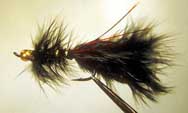
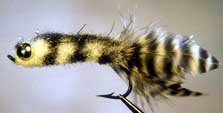
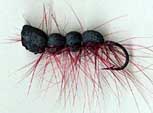
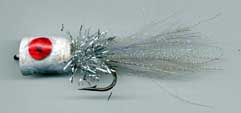
The types of the flies which I normally use when fishing from a moving boat.
On swift rivers the window which you have for fishing one place is small – not more than 3 casts. The first cast into the promising point I make downstream-and-across. To make the fly move it is necessary to retrieve the line rather fast – current is moving the boat downstream. When a cast is made across the current (even more so - when upstream-and-across), it is enough to hold the line. Near the bank the fly is always in slower water; tension of the line is making the retrieve. It is enough to animate the fly movement by small twitches of the rod tip.
In promising places the oarsman could slow the boat movement by rowing upstream. This will give the fisherman some time for extra casts. Fishing from a moving boat on one's own is less convenient and can be dangerous – not on every river it is possible to switch attention off from the floating. On the other hand, experienced rafter can fish almost all the time when he is in a boat. When fishing this way, it is often necessary to lay the rod aside and row. Because of this I am using floating line and dry (skating) flies, made out of deer fur or foam. This kind of fishing is emotional and saturated by events. Cast to the bank, check if the fly is not moving into snags, look downstream where the boat is going, lift the rod (maintain contact with a fly), put the rod back into the boat and make two oar strokes (the boat is too close to the bank). Splash near the bank, you can not see your fly and hook, the rod bends. Grip the rod with your knees or it will jump overboard, and take the oars. Do not forget to look, where the current is taking you; row away from the bank, row away from the obstacles, shorten the line and bring the fish close to the boat. If the fish is big, you will have to bring it to the nearby gravel bar.
Except aimed casting of a big fly, there other methods to fish from the moving boat. The easiest way is to use a nymph and drift it with a strike indicator in front of the boat. I think this fishing method is not more sport than bobber fishing with worms - or digging for worms. Fishing with the weighted nymph with no indicator is more difficult, which makes it more sport. Fisherman should make a cast not too close to the boat, and maintain some tension of the line, or the fly will snag the bottom.
By the way, fly-tackle could be used for trolling in rivers. Sometimes I pull a floating line with a “mouse” behind the boat. Surely, it is possible to do this only in wide slow pools, where one can (and should) row with his back facing downstream. By this method I used to catch lenok and taimen, including rather big specimens. A small skating fly, pulled behind the boat, is catching lots of grayling.
The last thing which I want to tell you about float-trips: if you have never floated a uninhabited wilderness river, try! It is unforgettable!
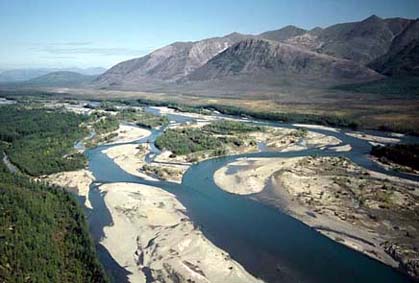
Yudoma River above the Gates
To the beginning of the article
Chapters of the book: Organization of wilderness trips
Zonation of the Russian Far East
Articles posted at this web-site
Glossary - fish Glossary - fishing
Home Fishing Flies Books & Articles Fishing tours About the author
FLYFISHING, OUTDOOR TRIPS, WILDERNESS PHOTOGRAPHY